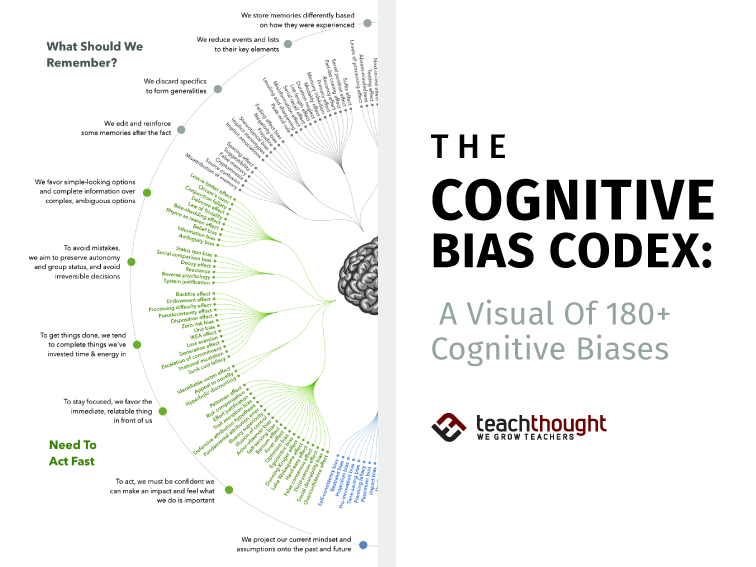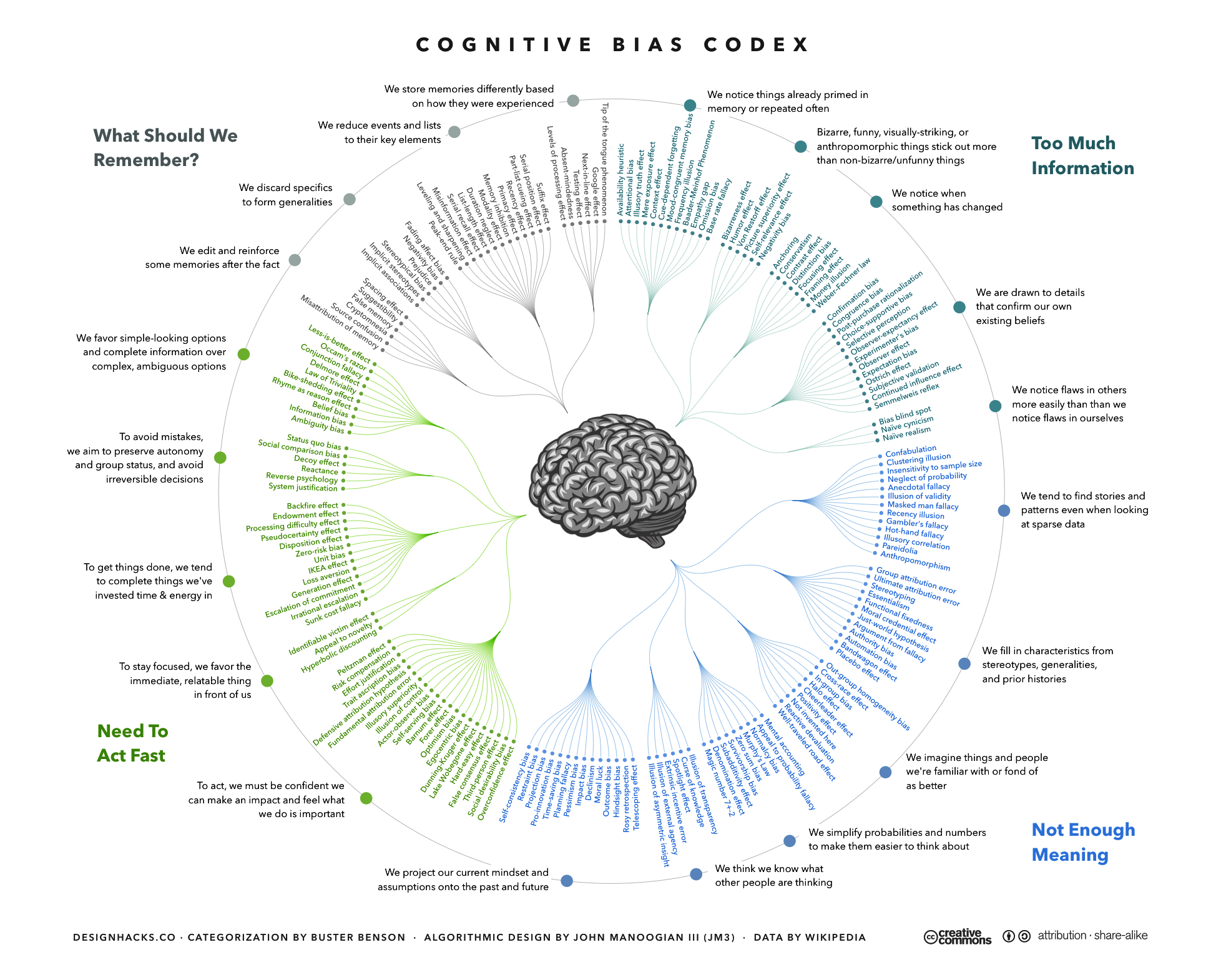
The List Of Cognitive Biases: A Graphic Of 180+ Heuristics
by Terry Heick
Cognitive biases are a kind of ongoing cognitive ‘condition’–tendencies to selectively search for and interpret data in a way that confirms one’s existing beliefs.
A cognitive bias is an inherent thinking ‘blind spot’ that reduces thinking accuracy and results inaccurate–and often irrational–conclusions.
Much like logical fallacies, cognitive biases can be viewed as either as causes or effects but can generally be reduced to broken thinking. Not all ‘broken thinking,’ blind spots, and failures of thought are labeled, of course. But some are so common that they are given names–and once named, they’re easier to identify, emphasize, analyze, and ultimately avoid.
See also The Difference Between Logical Fallacies And Cognitive Biases
And that’s where this list comes in.
Cognitive Bias –> Confirmation Bias
For example, consider confirmation bias.
In What Is Confirmation Bias? we looked at this very common thinking mistake: the tendency to overvalue data and observation that fits with our existing beliefs.
The pattern is to form a theory (often based on emotion) supported with insufficient data, and then to restrict critical thinking and ongoing analysis, which is, of course, irrational. Instead, you look for data that fits your theory.
While it seems obvious enough to avoid, confirmation bias is particularly sinister cognitive bias, affecting not just intellectual debates, but relationships, personal finances, and even your physical and mental health. Racism and sexism, for example, can both be deepened by confirmation bias. If you have an opinion on gender roles, it can be tempting to look for ‘data’ from your daily life that reinforce your opinion on those roles.
This is, of course, all much more complex than the above thumbnail. The larger point, however, is that a failure of rational and critical thinking is not just ‘wrong’ but erosive and even toxic not just in academia, but every level of society.
See also Complete List Of Logical Fallacies With Examples
The Cognitive Bias Codex: A Visual Of 180+ Cognitive Biases
And that’s why a graphic like this is so extraordinary. In a single image, we have delineated dozens and dozens of these ‘bad cognitive patterns’ that, as a visual, underscores how commonly our thinking fails us–and a result, where we might begin to improve. Why and how to accomplish this is in a modern circumstance is at the core of TeachThought’s mission.
The graphic is structure as a circle with four quadrants categorizing the cognitive biases into four categories:
1. Too Much Information
2. Not Enough Meaning
3. Need To Act Fast
4. What Should We Remember?
We’ve listed each fallacy below moving clockwise from ‘Too Much Information’ to ‘What Should We Remember?’ Obviously, this list isn’t exhaustive–and there are even subjectivities and cultural biases embedded within (down to some of the biases themselves–the ‘IKEA effect,’ for example). The premise, though, remains intact: What are our most common failures of rational and critical thinking, and how can we avoid them in pursuit of academic and sociocultural progress?
So take a look and let me know what you think. There’s even an updated version of this graphic with all of the definitions for each of the biases–which I personally love, but is difficult to read.
Image description: Wikipedia’s complete (as of 2021) list of cognitive biases, arranged and designed by John Manoogian III. Categories and descriptions originally by Buster Benson.

Too Much Information
We notice things already primed in memory or repeated often
Availability heuristic
Attentional bias
Illusory truth effect
Mere exposure effect
Context effect
Cue-dependent forgetting
Mood-congruent memory bias
Frequency illusion
Baader-Meinhof Phenomenon
Empathy gap
Omission bias
Base rate fallacy
Bizarre, funny, visually-striking, or anthropomorphic things stick out more than non-bizarre/unfunny things
Bizarreness effect
Humor effect Von Restorff effect
Picture superiority effect
Self-relevance effect
Negativity bias
We notice when something has changed
Anchoring
Conservation
Contrast effect
Distinction effect
Focusing effect
Framing effect
Money illusion
Weber-Fechner law
We are drawn to details that confirm our own existing beliefs
Confirmation bias
Congruence bias
Post-purchase rationalization
Choice-support bias
Selective perception
Observer-expectancy effect
Experimenter’s bias
Observer effect
Exception bias
Ostrich effect
Subjective validation
Continued influence effect
Semmelweis reflex
We notice flaws in others more easily than we notice flaws in ourselves
Bias blind spot
Naive cynicism
Naive realism
Not Enough Meaning
We tend to find stories and data when looking at sparse data
Confabulation
Clustering illusion
Insensitivity to sample size
Neglect of Probability
Anecdotal fallacy
Illusion of validity
Masked man fallacy
Recency illusion
Gambler’s fallacy
Illusory correlation
Pareidolia
Anthropomorphism
We fill in characteristics from stereotypes, generalities, and prior histories
Group attribution error
Ultimate attribution error
Stereotyping
Essentialism
Functional fixedness
Moral credential effect
Just-world hypothesis
argument from fallacy
Authority bias
Automation bias
Bandwagon effect
Placebo effect
We imagine things and people we’re familiar with or fond of as better
Out-group homogeneity bias
Cross-race effect
In-group bias
Halo effect
Cheerleader effect
Positivity effect
Not invented here
Reactive devaluation
Well-traveled road effect
We simplify probabilities and numbers to make them easier to think about
Mental accounting
Appeal to probability fallacy
Normalcy bias
Murphy’s Law
Zero-sum bias
Survivorship bias
Subadditivity effect
Denomination effect
Magic number 7+-2
We think we know what other people are thinking
Illusion of transparency
Curse of knowledge
Spotlight effect
Extrinsic incentive error
Illusion of external agency
Illusion of asymmetric insight
We project our current mindset and assumptions onto the past and future
Self-consistency bias
Resistant bias
Projection bias
Pro-innovation bias
Time-saving bias
Planning fallacy
Pessimism bias
Impact bias
Declinism
Moral luck
Outcome bias
Hindsight bias
Rosy retrospection
Telescoping effect
Need To Act Fast
We favor simple-looking options and complete information over complex, ambiguous options
Less-is-better effect
Occam’s razor
Conjunction fallacy
Delmore effect
Law of Triviality
Bike-shedding effect
Rhyme as reason effect
Belief bias
Information bias
Ambiguity bias
To avoid mistakes, we aim to preserve autonomy and group status and avoid irreversible decisions
Status quo bias
Social comparison bias
Decoy effect
Reactance
Reverse psychology
System justification
To get things done, we tend to complete things we’ve time & energy in
Backfire effect
Endowment effect
Processing difficulty effect
Pseudocertainty effect
Disposition effect
Zero-risk bias
Unit bias
IKEA effect
Loss aversion
Generation effect
Escalation of commitment
Irrational escalation
Sunk cost fallacy
To stay focused, we favor the immediate, relatable thing in front of us
Identifiable victim effect
Appeal to novelty
Hyperbolic discounting
To act, we must be confident we can make an impact and feel what we do is important
Peltzman effect
Risk compensation
Effort Justification
Trait ascription bias
Defensive attribution hypothesis
Fundamental attribution error
Illusory superiority
Illusion of control
Actor-observer bias
Self-serving bias
Barnum effect
Forer effect
Optimism effect
Egocentric effect
Dunning-Kruger effect
Lake Wobegone effect
Hard-easy effect
False consensus effect
Third-person effect
Social desirability bias
Overconfidence effect
What Should We Remember?
We store memories differently based on how they are experienced
Tip of the tongue phenomenon
Google effect
Next-in-line effect
Testing effect
Absent-mindedness
Levels of processing effect
We reduce events and lists to their key elements
Suffix effect
Serial position effect
Part-list cueing effect
Recency effect
Primary effect
Memory inhibition
Modality effect
Duration neglect
List-length effect
Serial recall effect
Misinformation effect
Leveling and sharpening
Peak-end rule
We discard specifics to form generalities
Fading affect bias
Negativity bias
Prejudice
Stereotypical bias
Implicit stereotypes
Implicit association
We edit and reinforce some memories after the fact
Spacing effect
Suggestibility
False memory
Cryptomnesia
Source confusion
Misattribution of memory
Creative Commons Attribution: Share-Alike
The Cognitive Bias Codex: A Visual Of 180+ Cognitive Biases